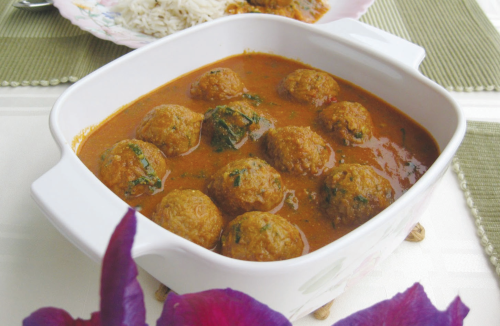Mama’s Punjabi Recipes: Bhaen De Kofte (Curried Lotus Root Balls)
 In the West, bhaen (lotus root) is one of the most misunderstood vegetables – even among desi kids who have grown up in the US – and one that is seldom encountered in restaurants or grocery stores. In Asia, on the other hand, lotus root is commonly available in long stalks and is well known for its culinary uses.
In the West, bhaen (lotus root) is one of the most misunderstood vegetables – even among desi kids who have grown up in the US – and one that is seldom encountered in restaurants or grocery stores. In Asia, on the other hand, lotus root is commonly available in long stalks and is well known for its culinary uses.
In China, it is known as lian ou and is used in soups, salads, with meats and even in desserts. In the Punjab, bhaen are prized for their crunchiness and highly fibrous texture which allows them to be made dry, curried and even into pickles. When made with a thick curry, some even swear that they taste like meat! Kofta is a word that is used in the Indian Subcontinent, Caucases, Balkans, Middle East and Central Asia often to refer to a meatball, though the vegetarian cuisines of India use it universally as a “ball” dish.
The lotus flower is a divine symbol in Hinduism and many other Asian cultures, representing purity and non-attachment. Vishnu and Lakshmi are often portrayed on a pink lotus, and the Goddess Sarasvati is portrayed on a white lotus, as are also Ganga and Ganesh.
While the lotus flower grows on top of pods of large leaves that float on the surface of the water, its fast growing roots are long underwater and can extend to a length of four feet. Lotus roots are very beneficial as they are rich in fiber, vitamin C, potassium, thiamin. Riboflavin, vitamin B5, phosphorus, copper and manganese. Chinese lotus roots are often pink and larger in diameter, softer and have a delicate taste.
The Indian variety, on the other hand, are reddish brown and narrower, with a greyish-white interior that is lacey, and have a texture that is slightly crunchy and mildly sweet. The roots usually grown in soft soil and stagnant water so they have to be thoroughly washed and then boiled before being consumed. When buying lotus root, especially to sauté, be sure to test if the stalk breaks easily; if it is hard, then the dishes will not turn out well.
Ingredients:
• 250 gm bhaen (lotus roots)
• 1 cup besan (chickpea flour)
• 2 tbsp tael (oil) vegetable or olive oil
• Spices (to taste): namak (salt), mirch (red pepper), dhania (coriander powder)
Ingredients for curry masala:
• 1 large pyaaz (onion) – peeled and chopped
• 4 cloves of lasan (garlic) – peeled and chopped
• 1 medium adrak (ginger) – peeled and chopped
• 1 medium tamater (tomato) – chopped or 1 tsp tomato paste
• 2 cups pani (water)
• Spices (to taste): namak (salt), mirch (red pepper), dhania (coriander powder), haldi (turmeric)
Directions:
1. Wash the bhaen thoroughly to remove all the dirt off them then peel the stalks and cut them into 2 inch long pieces.
2. Place in a pot of water and bring them to a boil for 10 minutes. When they are soft to touch, take off the heat and drain the water.
3. Place the bhaen pieces in a mixee to mash or mash them by hand in a bowl. Add the besan and spices and mix well till it is a semi-soft batter.
4. In a kadai or wok add some vegetable oil and heat on high. Make one inch balls out of the batter and drop into the hot oil and deep fry till they are golden brown. Let the pakoras sit on paper towels to drain the oil.
5. To make the curry masala, heat 2 tbsp of oil in a pot. Now add the curry masala ingredients and the rest of the salt, pepper and coriander and water except the tomato and stir till it becomes a little brown. When roasted and the smell of the pieces starts to come through, add the chopped tomato (and tomato paste) and brown a little more till it becomes a paste. Be careful not to overcook, then add 2 cups of water and bring to a boil for 10 minutes till it thickens.
6. Now drop in the fried bhaen pakoras into the turri and let them simmer for 2 minutes. Turn off the heat and keep covered for a few more minutes before serving with hot roti (bread).
MAMA’S TIP OF THE WEEK: BOILING POTATOES IN THE PRESSURE COOKER LEAVES STAINS
Some cooks swear that they can’t live without their pressure cookers, using them to make daals (lentils), channe (chickpeas), potatoes and other items. But my experience is that the pressure cooker is overused by people in a hurry and the results can often be less than satisfactory. If left overdone, the daals and potatoes become too soft and mushy, become soups or mashed instead.
One thing to be careful about is that cooking potatoes in pressure cookers will usually leave a residue and stain the insides. Be sure to wash the vessel thoroughly so that it is clean and has no stain from the starch or for best results use steel wool scrubbers like Brillo pads.

Shakuntla Malhotra is a skilled cook of Punjabi dishes made in the old-fashioned style that she learnt as a young woman in her ancestral home in Lyallpur, India (since renamed Faisalabad) before it became part of Pakistan after the Partition in 1947. People have often admired her cooking for its simplicity and taste that comes with each mouthful. Even in her late-eighties, she continues to cook daily and agreed to share her delectable Punjabi recipes for future generations.
